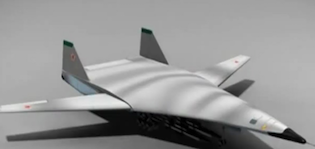Russia conducted a flight test of a revolutionary hypersonic glide vehicle that will deliver nuclear or conventional warheads through advanced missile defenses, U.S. defense officials said.
The test firing of the hypersonic glider took place Tuesday and involved the launch of an SS-19 intercontinental ballistic missile from eastern Russia, said officials familiar with details of the test.
Russia’s state-run Interfax news agency confirmed the test on Thursday.
Pentagon spokeswoman Lt. Col. Michelle Baldanza said: "While we have seen the reports in the media, the Department of Defense has nothing to offer on this."
Tuesday’s test was only the second known test of a new hypersonic glider. An earlier test took place last year.
China and the United States also are developing hypersonic missiles, both gliders and jet-powered vehicles that travel at extreme speeds.
China has conducted six tests of its DF-ZF hypersonic glider.
A U.S. Army hypersonic missile blew up shortly after launch in August 2014. The Pentagon also is developing a scramjet-powered hypersonic weapon.
Hypersonic missiles are being developed to defeat increasingly sophisticated missile defenses. The weapons are designed for use in rapid, long-range strikes.
Interfax, quoting a source familiar with the Russian test, confirmed it involved a "prototype hypersonic aircraft" that will be deployed on current and future long-range missiles.
The test was carried out in the Orenberg region of Russia, located near the border with Kazakhstan.
The hypersonic glider was launched atop an SS-19 missile and the test was said to be successful, the news agency said.
Earlier, Russia’s Moskovsky Komsomolets reported that the new hypersonic glider was tested from a missile launched at the Dombarovsky missile base in Orenberg, where SS-18 missiles are deployed.
A defense official told the Washington Free Beacon preliminary indications were the test was successful. No details were provided on how fast the vehicle went or the distance it traveled.
Hypersonic speed is between Mach 5 and Mach 10, or 3,836 miles per hour to 7,673 miles per hour. Hypersonic weapons pose technological challenges for weapons developers because the speeds create high heat and pressure that make flight and precision targeting difficult.
Russia has made developing hypersonic weapons a high priority.
Gen. Valery Gerasimov, chief of the Russian general staff, stated in May 2013 that Moscow opposed further nuclear arms talks because of U.S. development of precision-guided hypersonic weapons that could be used in place of some nuclear weapons.
Gerasimov was referring to the X-37B space plane and other systems in development that could be used in what the Pentagon calls conventional Prompt Global Strike—weapons capable of hitting any target on earth within 30 minutes.
Russian Deputy Prime Minister Dmitri Rogozin has said that "whoever is first to achieve" mastery of hypersonic weapons would "overturn the principles" of how wars are waged. He also compared hypersonic weapons development as on par with development of nuclear arms.
U.S. intelligence officials have disclosed to Congress in testimony that China’s DF-ZF hypersonic gliders appear designed to deliver nuclear warheads through missile defenses. However, the high-speed DF-ZF also could be used with conventional warheads as part of what the Pentagon calls "anti-access, area denial" weapons China is developing to threaten U.S. forces near China’s coasts.
Last week during a congressional hearing, Missile Defense Agency Director Vice Adm. James Syring was asked whether his agency is working to counter the threats from Chinese and Russian hypersonic strike weapons.
Syring disclosed plans to build laser weapons to counter hypersonic threats. "I’ve asked for $23 million to begin a low-power laser demonstrator this year to demonstrate the feasibility by 2021," the three-star admiral told the House Armed Services strategic forces subcommittee.
Rep. Mike Rogers (R., Ala.), chairman of subcommittee, expressed concern about the hypersonic threat.
"I’m troubled that Russia and China continue to outpace the U.S. in development of these prompt global strike capabilities, complain about our tepid development programs, and the Obama administration’s ideological reductions to the Missile Defense Agency budget have denied that agency the resources to do anything to develop defenses," Rogers told the Washington Times.
Mark Schneider, a former Pentagon strategic forces policymaker, said if the reports of the test are confirmed "it is a major threat development."
"Russia has an extensive program underway on hypersonic vehicles," Schneider said. "This year the Russian state media is reporting that a hypersonic cruise missile is being developed for Russian naval vessels including the ‘5th generation’ Husky missile submarine that is now under development."

The new anti-ship missile, known as Tsirkon, will be in operation by 2018. Russian press reporting has indicated that the new Pak DA stealth bomber under development will also be armed with air-launched hypersonic missiles.
"U.S. programs involving hypersonic vehicles are modest by comparison," Schneider said. "I would be surprised if we actually deploy one. If we do, it will likely be conventional. Russian hypersonic vehicles will likely either be nuclear armed or nuclear capable since this is the norm for Russia."
Jane’s Intelligence Review disclosed last year that the Russian hypersonic strike vehicle is called the Yu-71. The report said the Russians could deploy up to 24 hypersonic gliders as nuclear delivery vehicles at Dombarovsky between 2020 and 2025.
Geneva-based military analyst Pavel Podvig, who runs the blog Russianforces.org, said the program for the glider is code-named as Project 4202.
Podvig said a test flight of the glider was expected.
"Whether it was successful, as the reports allege, or not, we don't know," he said.
